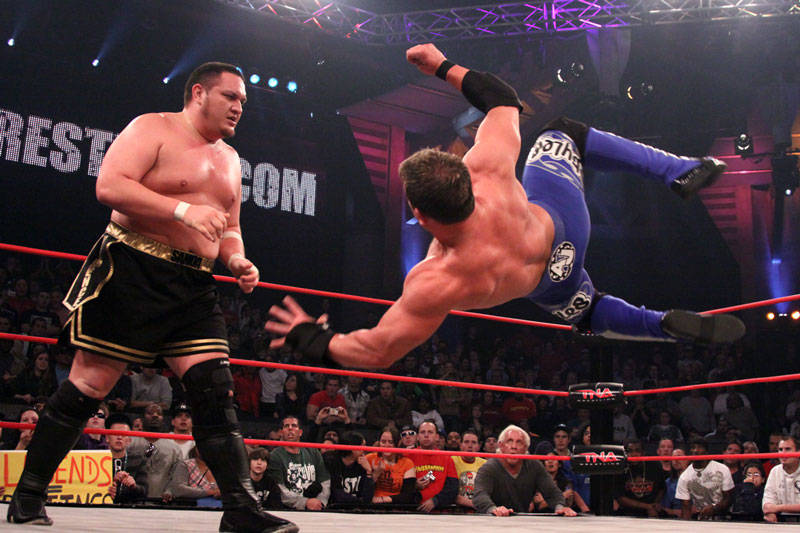Culture
The Spinning Lariat: It’s an art

Every Friday, The Spinning Lariat brings you Trent Zuberi’s observations on the latest developments in America’s other major wrestling promotion, TNA.
It’s an art. That’s an answer I use frequently when people ask me why I love professional wrestling as much as I do. That answer leaves them confused at times. To the average person the words art and professional wrestling don’t really belong together, but what they fail to realize is how much of an art it really is. Television shows are considered an art. Stage plays are considered an art. Musical concerts are considered an art, why not professional wrestling? It, like the aforementioned forms, is also performed on a stage for an audience, so why doesn’t it get the same treatment? The quick answer non-fans like to use is because it’s scripted. So is CSI, what else you got? Oh, because it’s “fake.” Mind you, these are the same people who tune in by the millions to watch Academy Awards shows where guys like Russell Crowe get awards and praise for films they make because yes, Gladiator is totally real.
When I thought about it further, I realized why the negativity for this classification exists. There’s always a romantic memory everyone has when it comes to professional wrestling. The “Oh I used to watch it when I was a kid” or “my dad watched it” are popular ones, and the common denominator between those memories is that way back when, we all thought it was real. We fell in love with it because we got invested in what they were showing us. Emotions were attached to it and that made people more involved. But then what happened? The curtain was pulled back and they showed us how it all works. The magician revealed his tricks to us, and a large amount of fans almost felt betrayed. I think people to this day wished it was the real soap opera they hooked themselves to, but when it “betrayed” them by saying that none of it really happened, the word “fake” took over.
Now in the world of the superfans, the word “fake” is detested. Are the secrets revealed? Yes. But do we know what is going to happen minute to minute? Not always, and that’s the hook. In today’s day and age the art of professional wrestling has evolved. Performers have to try harder and find those new bursts of creativity to keep us on our toes, and when done right it’s a magical combination. The storylines are important, without a doubt. Compelling storytelling is a big part of the machine that is professional wrestling, but there’s also the story told in the ring. Ric Flair once said “The name on the marquee still says wrestling,” and he’s absolutely right. At the end of the day, every story culminates between the ropes, and that is where said story becomes reality.
This past week’s episode of TNA Impact featured a match that hit that nerve for me. I’ve seen AJ Styles and Samoa Joe fight each other probably 50+ times, and it never gets old. This one had a different twist. AJ’s character is in a completely different state of mind than the fans are used to. He’s darker, more aggressive, less explosive and more methodical than ever before. This even isn’t the AJ that Joe is used to battling, so he had to adapt as well. Joe is more systemized and calculated than before; he’s breaking opponents down in a more concentrated way than I’ve seen in the past. This is where the art comes in. The match started slow. There was a feeling-out process to get the basic familiarity down. Why would two guys who know each other back and forth need that? Aha, more art! Joe knows AJ has changed; he has to see how this new AJ starts the match and make him work his style. It’s the small details, folks. Anyway, they went back and forth a bit, calculated to the point where for the first few minutes you would think the two had never met in the ring before. The art here is that the two slowly built the battle up.
By the ten-minute mark, this match was at a fever pitch. The two were going move for move with no wasted motion at all. The crowd was engaged and along for the ride and the viewing audience collectively hit that moment where we didn’t know who was going to win and how. Every little detail, from each competitor’s facial expressions to their body language, told a little bit more of the story. The match was set for a 15-minute time limit, and as we approached the final minute the race to the finish line began. Each man showed that desperation to win with whatever skills they could use. Every move could be the last, but to no avail; the match ended in a time limit draw.
Exciting to the last second, the two were pulled apart, and as they settled themselves they were engulfed by chants of “Let them fight!” and ”Five more minutes!” from thousands of fans. The audience was on its feet. The equivalent of a standing ovation at a theater or a call for an encore at a concert, their audience wanted more. In fifteen minutes, two wrestlers that wouldn’t be given the credit they deserve from the mainstream for the artists they are brought thousands of people to their feet demanding they continue their performance. That, my friends, is amazing storytelling. That is pure art.
(Questions, comments, feedback? Please feel free to contact me at trentzuberi@gmail.com)